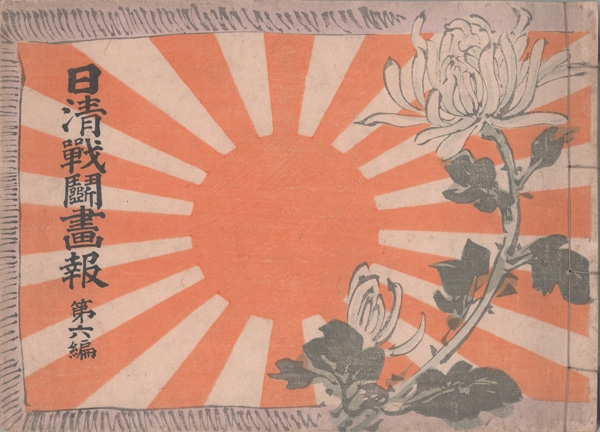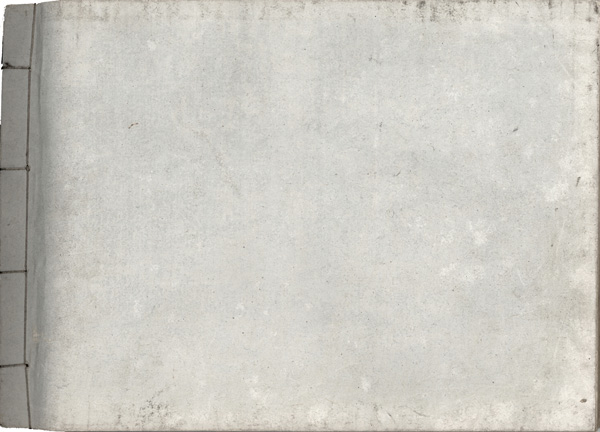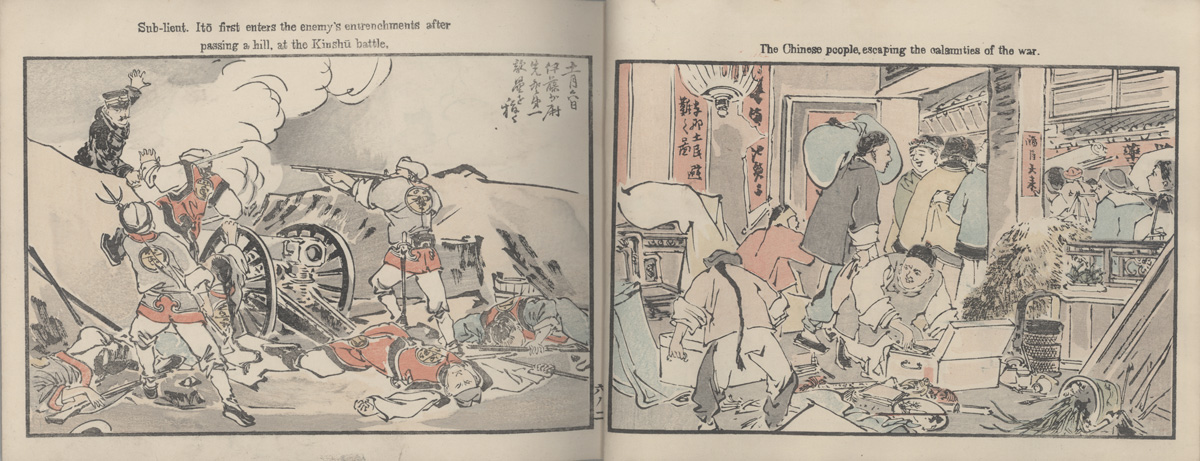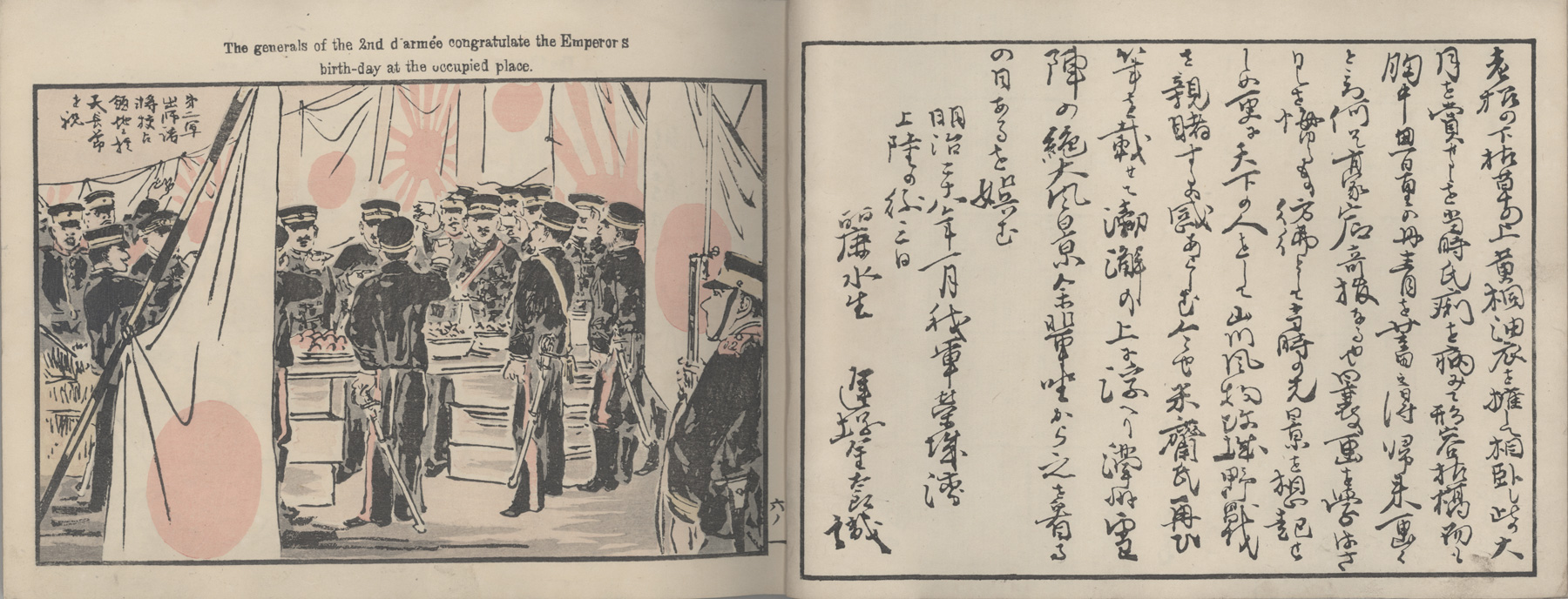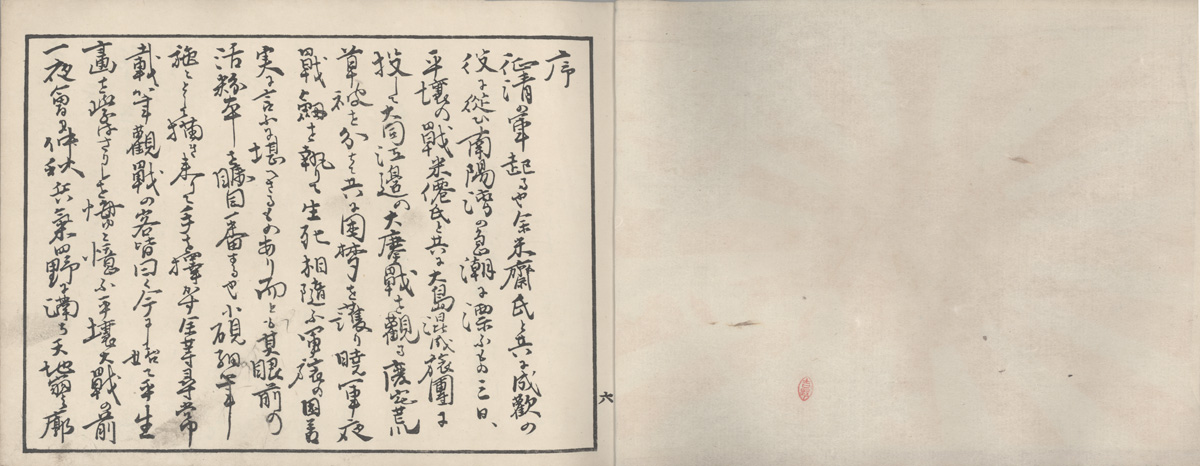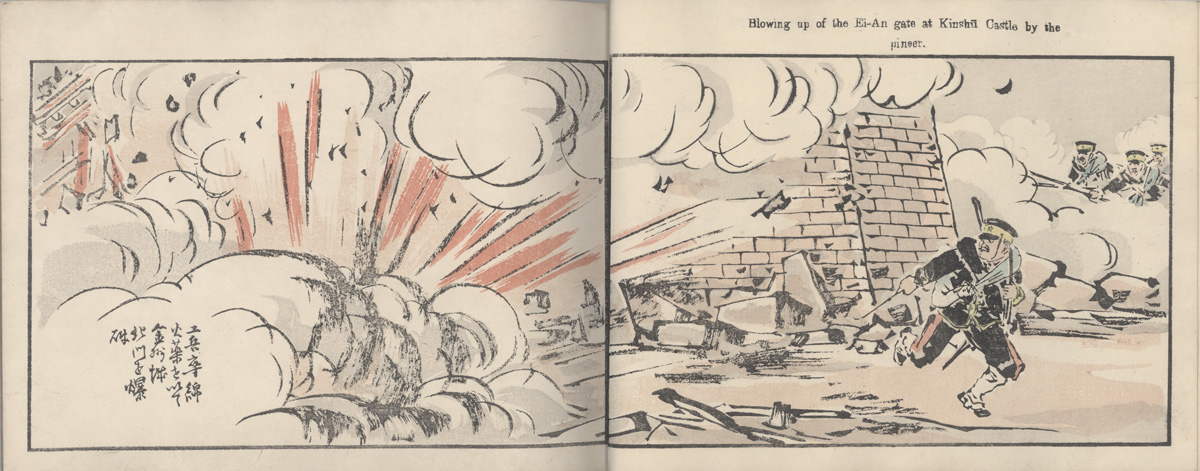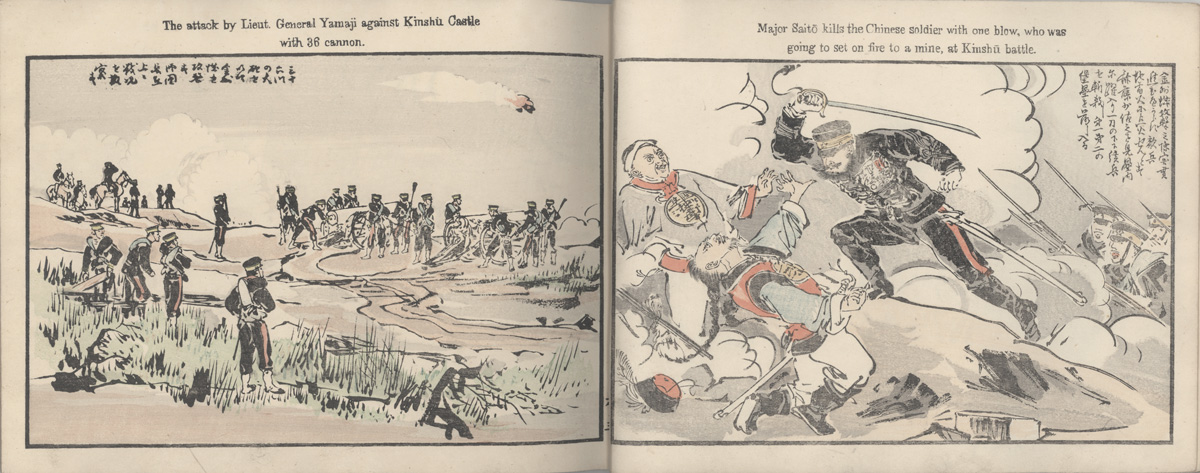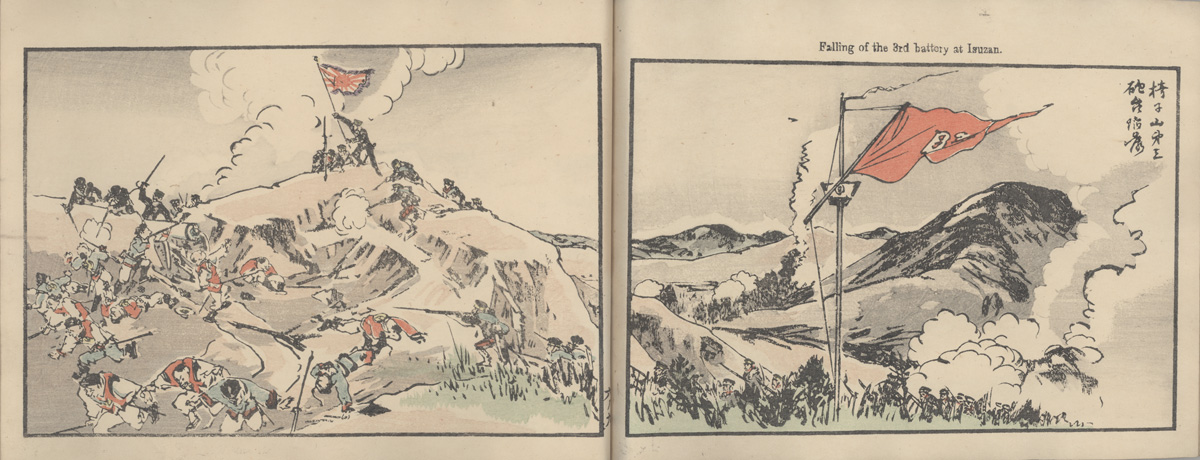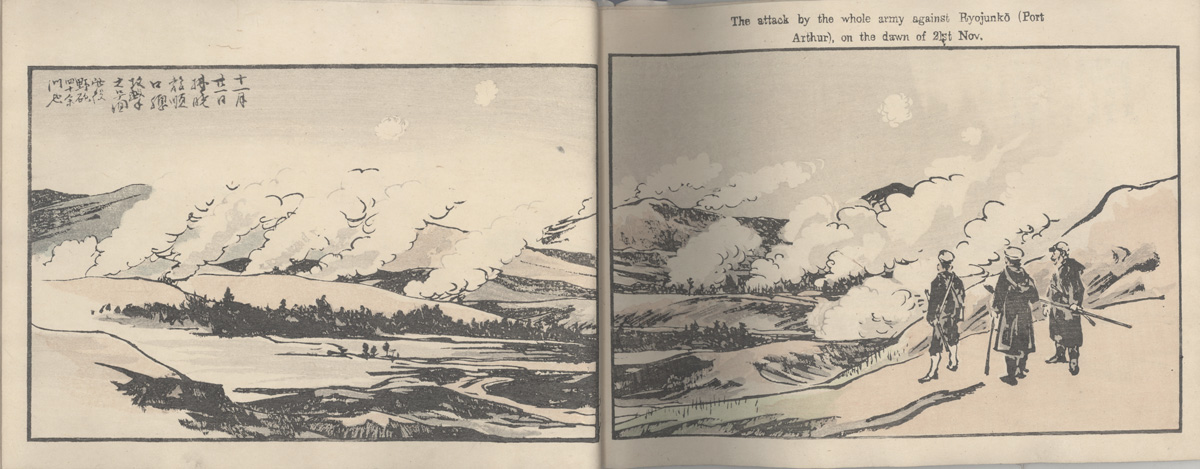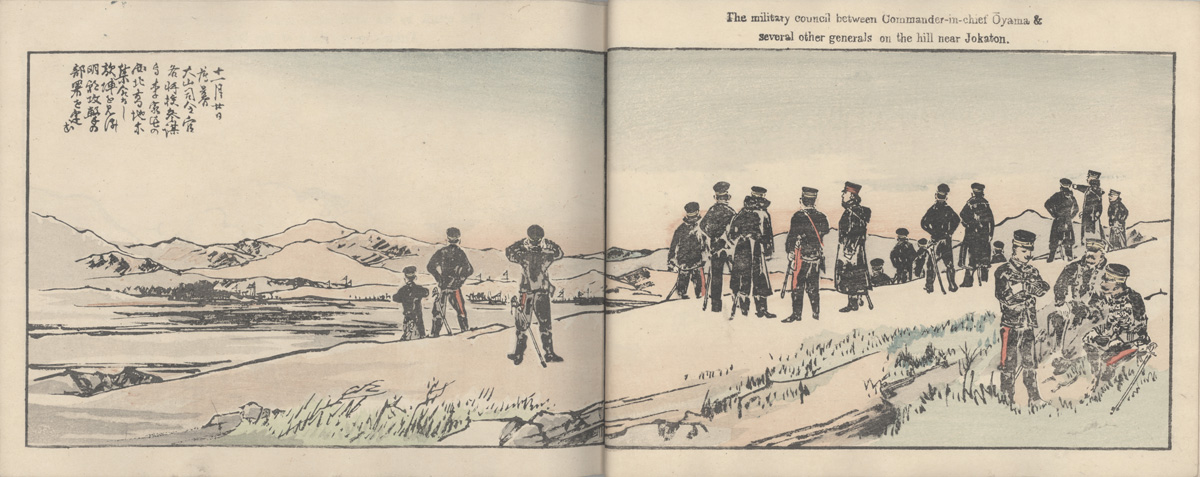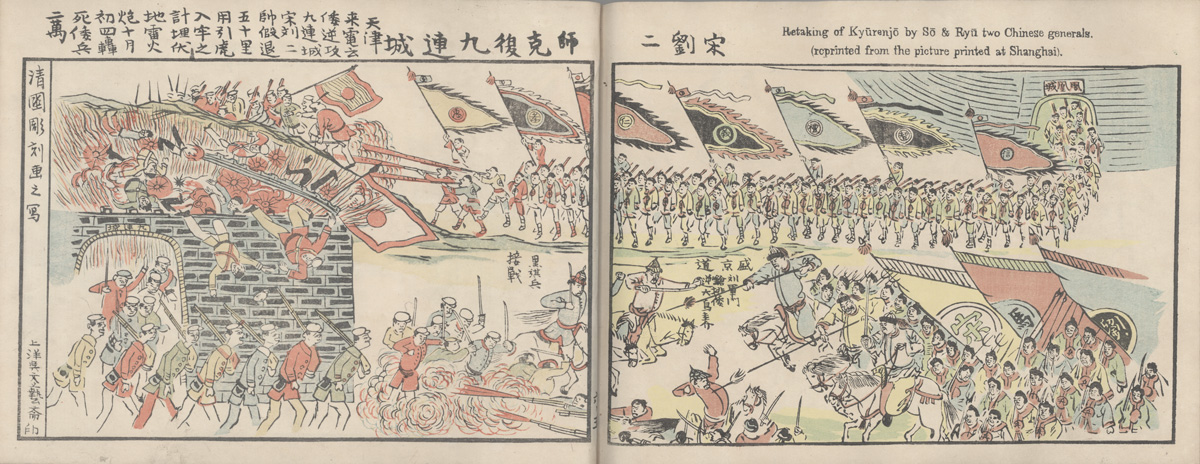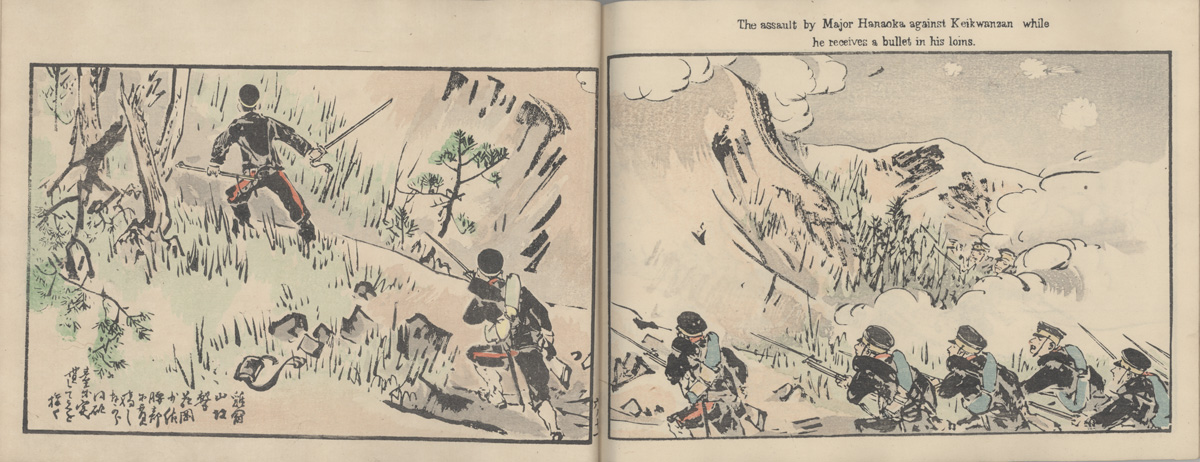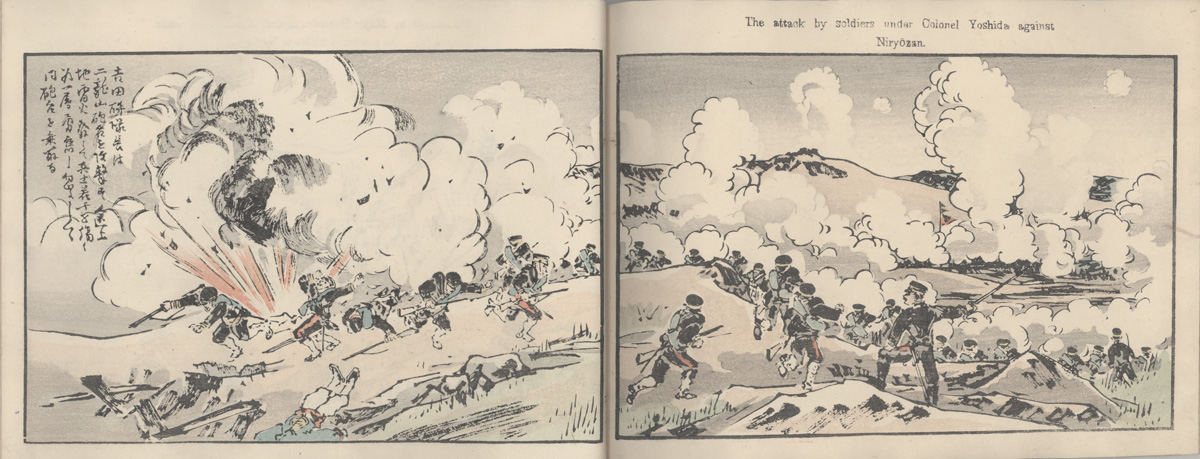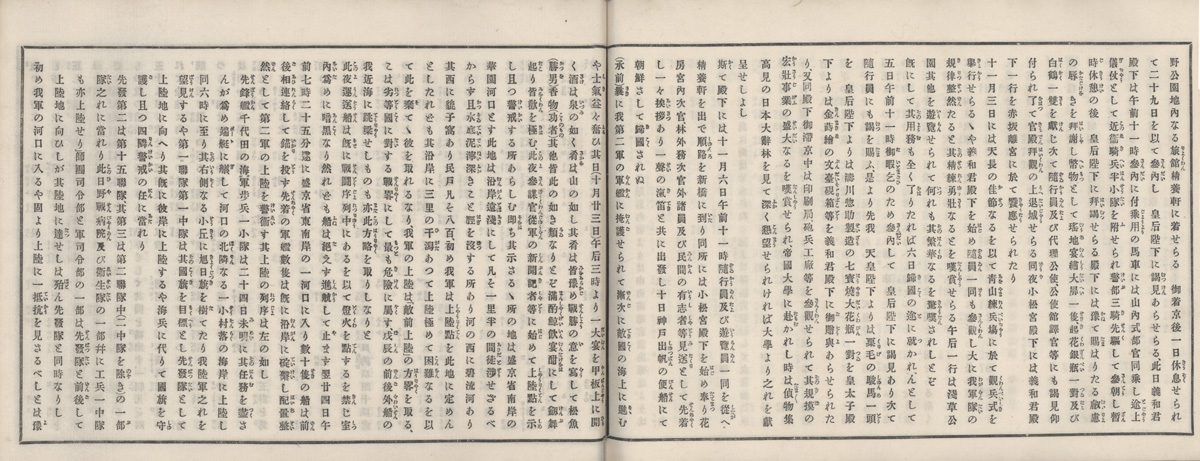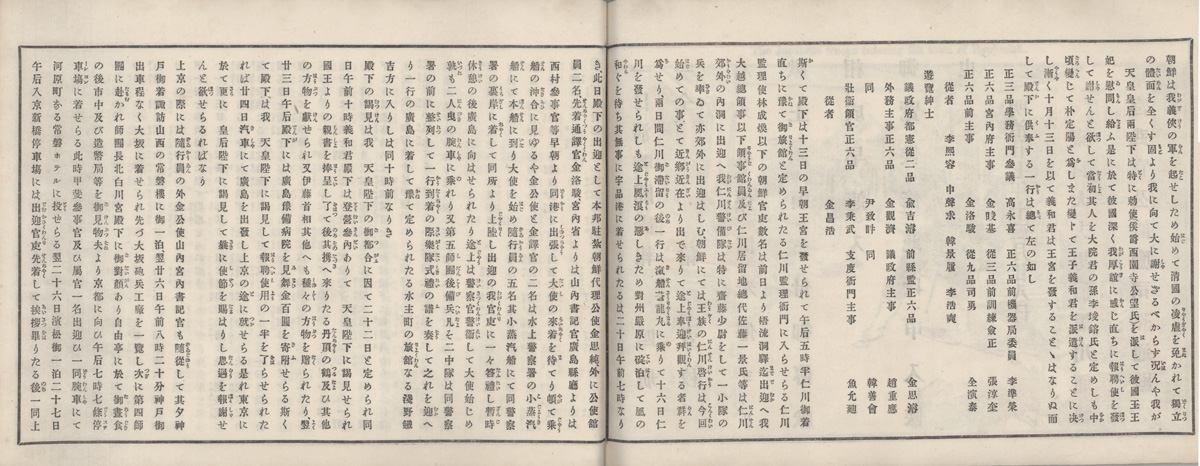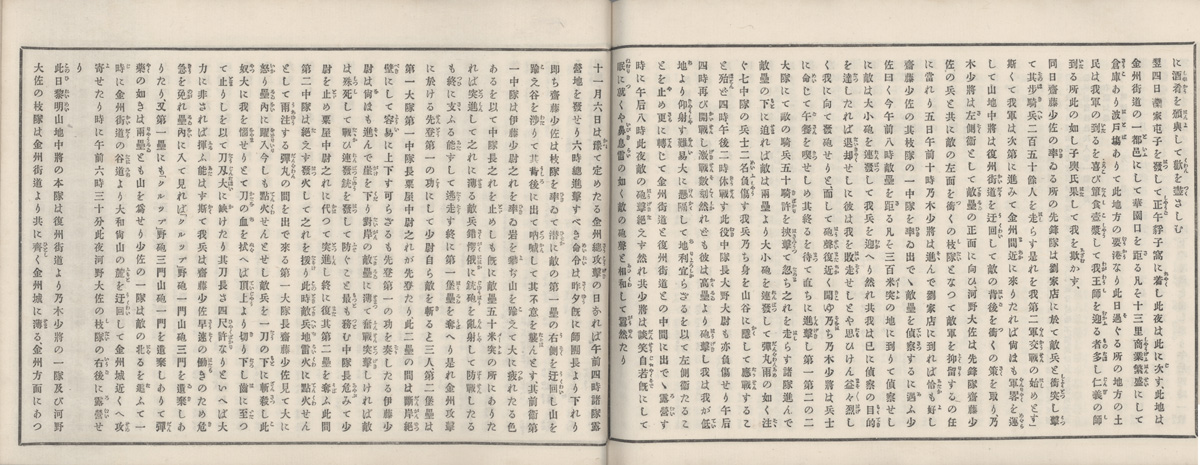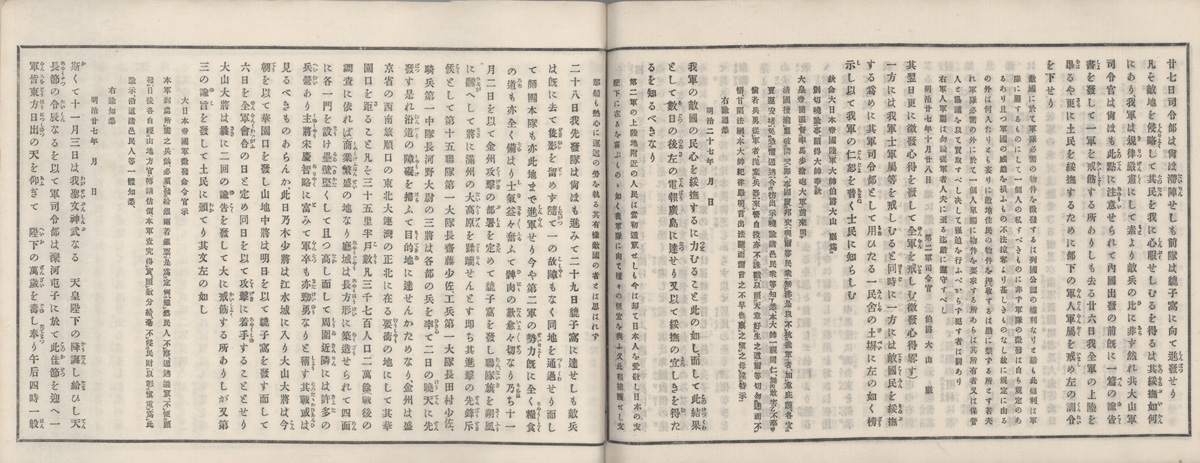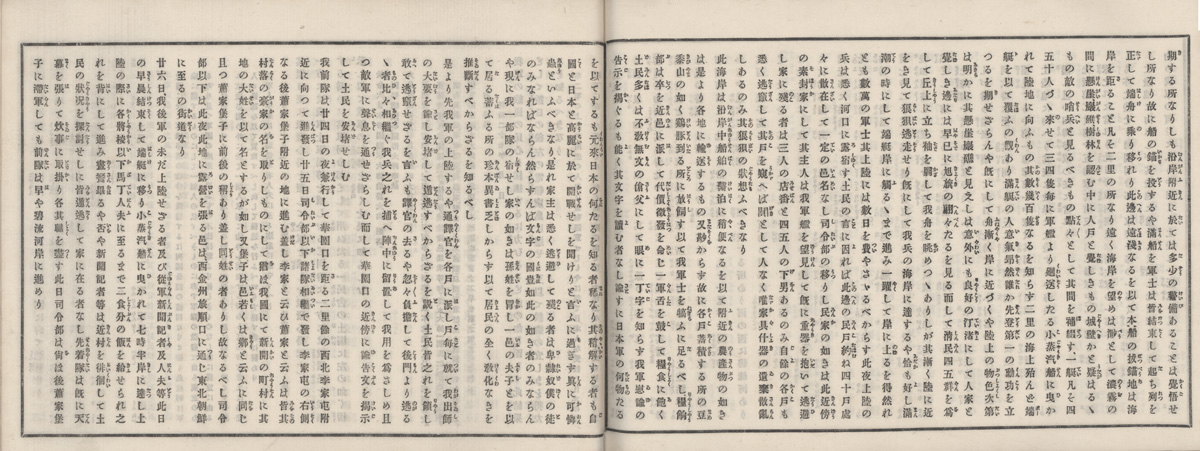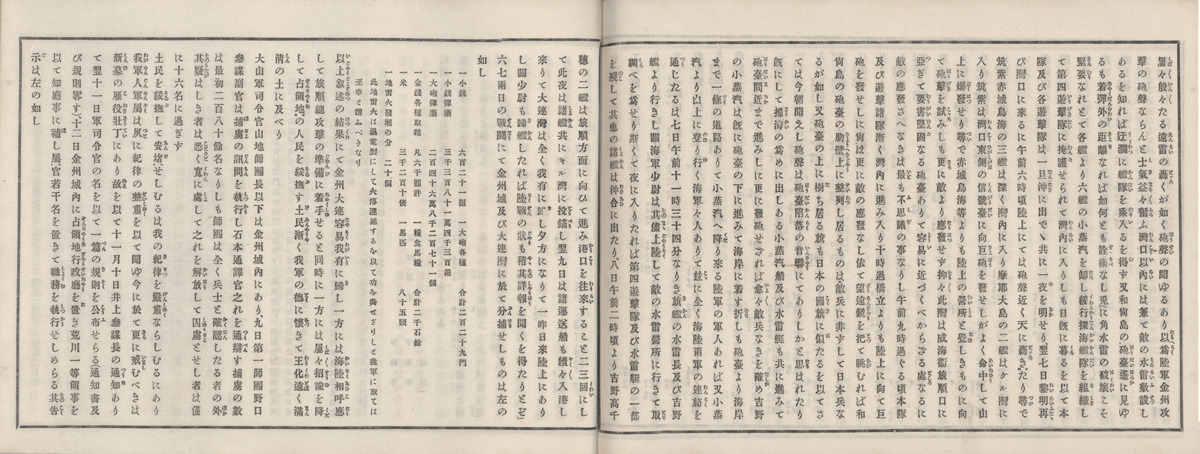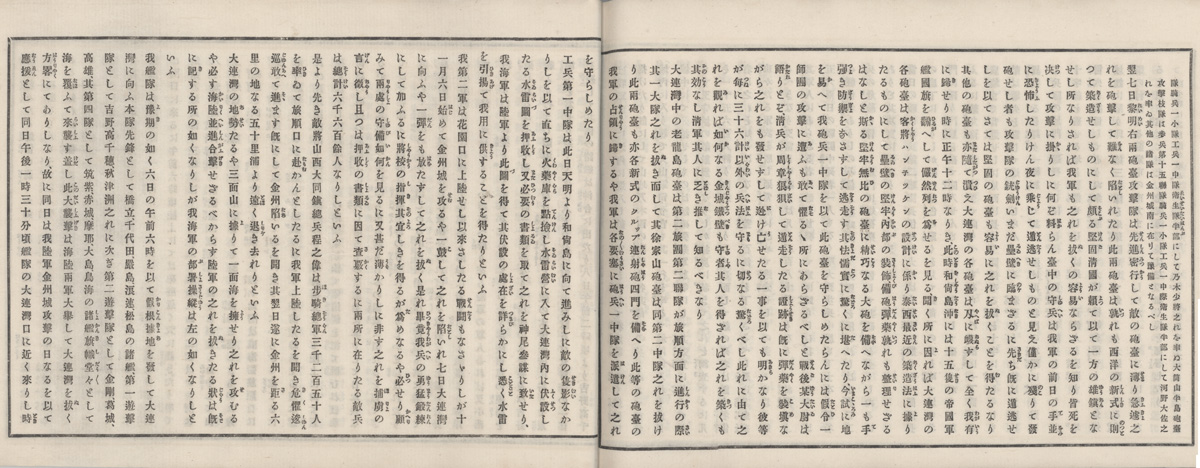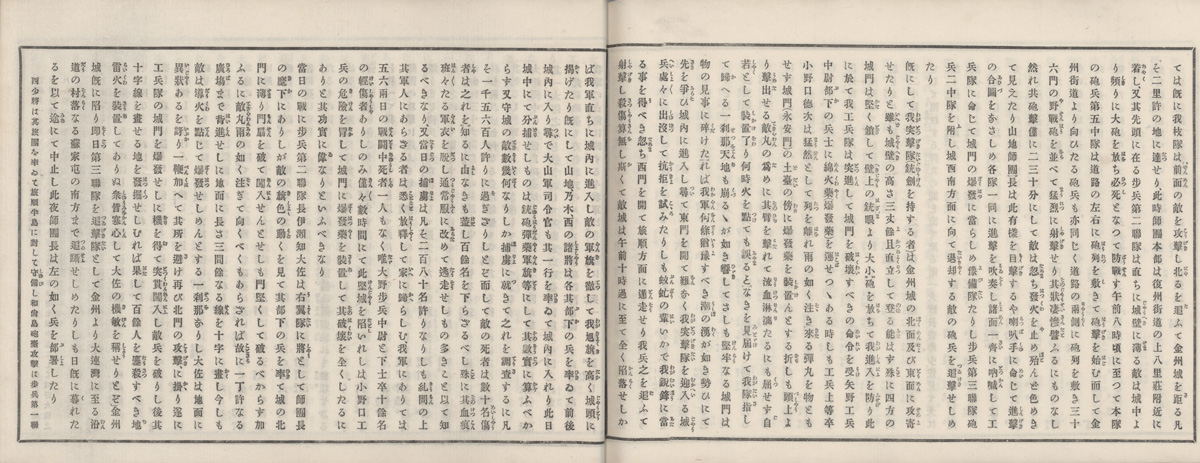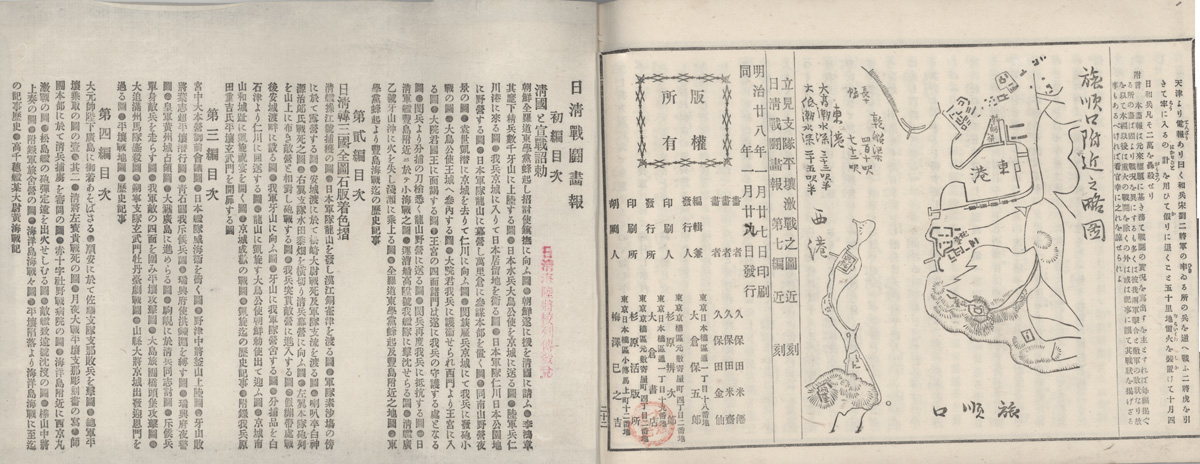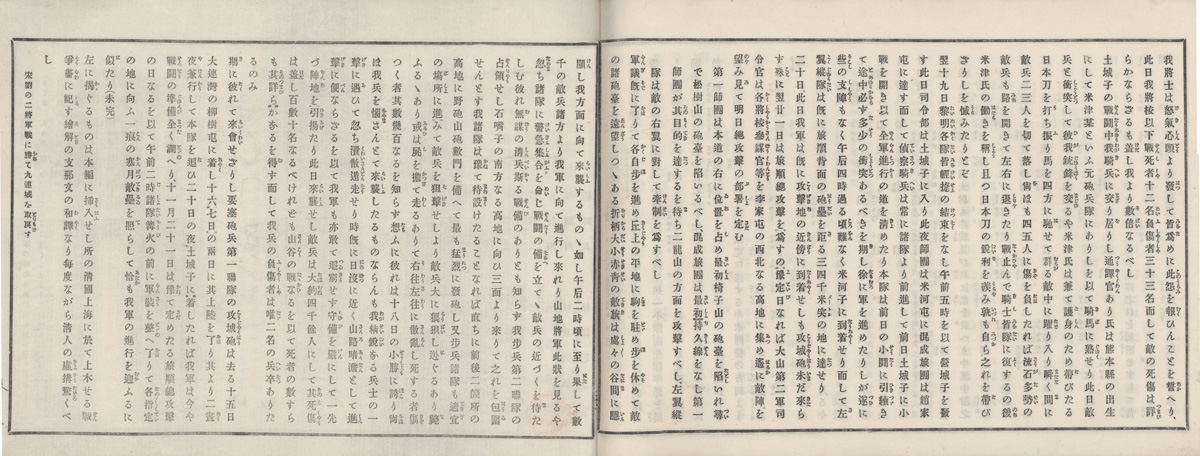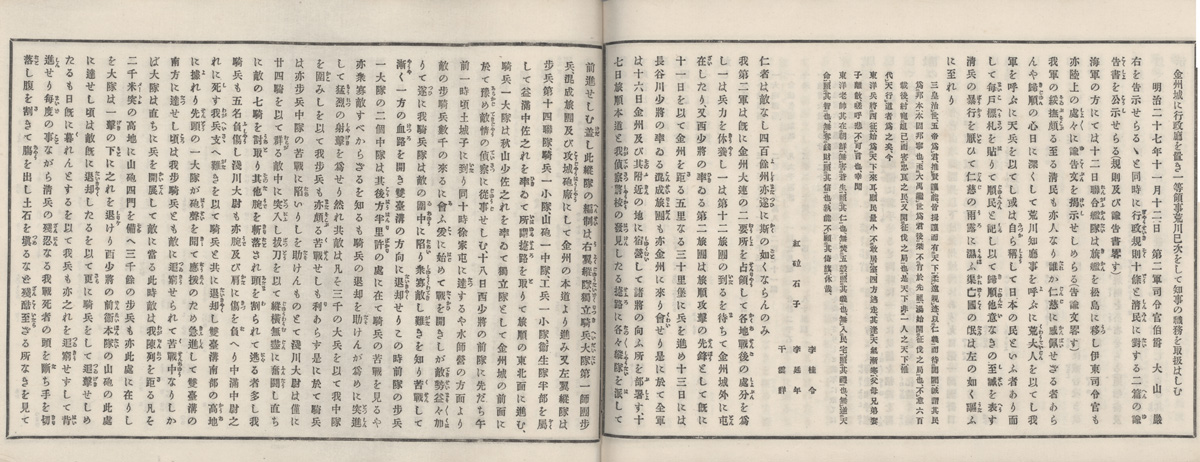About This Book
Volume 6 of a total of eleven bound volumes1 forming a pictorial account of the first Sino-Japanese War, from its outbreak in the summer of 1894 to Japan's sea-victories at Weihaiwei, Japan's advance into Manchuria and finally the peace treaty ending the war in April 1895. The eleven volumes were published at irregular intervals between October 21st 1894 and June 6th 1895. Each volume has an introduction written by a well-known figure of the time. The books were produced from carved woodblocks and are bound in the usual method of "bound-pocket books" (Fukuro toji 袋綴じ). Volumes 5 through 11 have English captions above the illustrations.
The illustrations in these books were widely dispersed overseas to an audience closely following the war, as can be seen from the below illustrations from Volume 6 that appeared in the 1895 French publication Revue Encyclopédique: Recueil Documentaire Universel et Illustré, published by Georges Moreau in Paris.
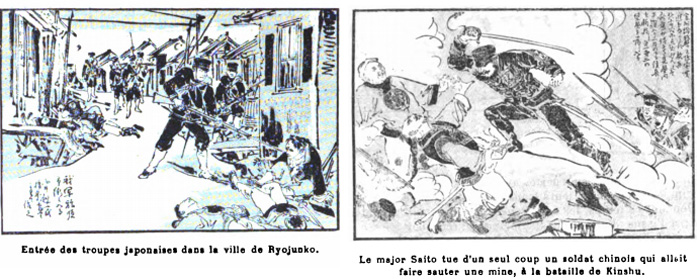
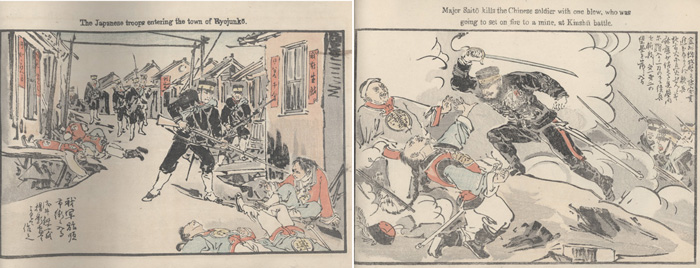
Images as they appear in Volume 6 of Illustrated Account of the Sino-Japanese War
Source: Japan at the Dawn of the Modern Age – Woodblock Prints from the Meiji Era, Louise E. Virgin, Donald Keene, et. al., MFA Publications, 2001, p. 68.
"A unique and important source of inspiration for the Sino-Japanese War print artists was the journalistic reports written and illustrated by the Kyoto painter Kubota Beisen (1852-1906). Accompanied by his two sons, Beisai and Kinsen, Beisen actually followed the troops [the First Army division] and recorded their battles in words and sketches. And Beisen himself was depicted almost as a war hero in a small number of triptych designs." (See the print Ban-Banzai for the Great Japanese Empire! Illustration of the Assault on Songhwan: A Great Victory for Our Troops.)
Source: A Much Recorded War: The Russo-Japanese War in History and Imagery, Fredrick A. Sharf, Anne Nishimura Morse, Sebastian Dobson, MFA Publications, 2005, p. 40-41.
"In their ten-volume2 Illustrated Record of the Battles of the Sino-Japanese War, from 1894-95, Beisen and his two sons describe the events of the war against a landscape this is beholden to East Asian literati painting and prints, with fibrous texture strokes used to define mountainsides and riverbanks and stippling to suggest the foliage on the trees. Yet the artists have consistently modeled the figures of the Japanese soldiers with light and darks to heighten the solidity of their forms. This modeling contrasts with the time-honored use of simple hooked outlines to define the figures of the Chinese combatants."th the time-honored use of simple hooked outlines to define the figures of the Chinese combatants."Source: A Much Recorded War: The Russo-Japanese War in History and Imagery, Fredrick A. Sharf, Anne Nishimura Morse, Sebastian Dobson, MFA Publications, 2005, p. 40-41.
Advertisement
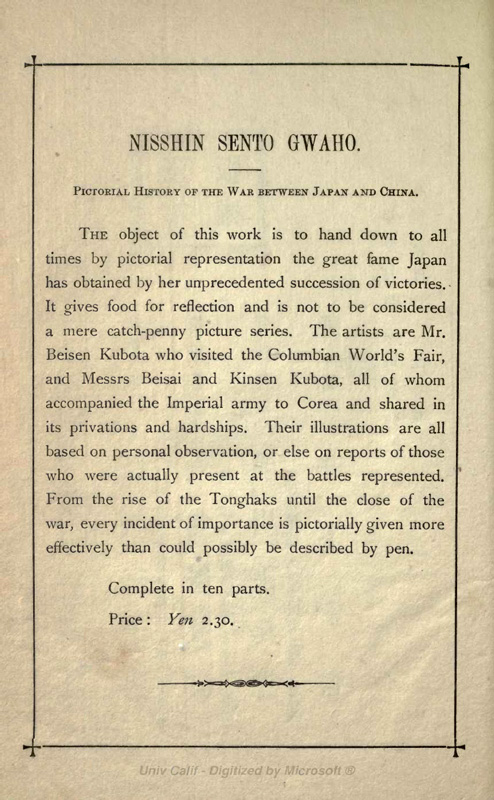
Ad appearing in A Concise History of the War Between Japan and China,
compiled by Jikichi Inouye, Osaka: Z. Mayekawa, Tokyo: Y. Okura, 1895.
compiled by Jikichi Inouye, Osaka: Z. Mayekawa, Tokyo: Y. Okura, 1895.
[note: while the ad states "Complete in ten parts." an eleventh volume was added at a later date.]
2015 Reprint of All Eleven Volumes
I n 2015, the Osaka publisher Sōgensha 創元社 reprinted all eleven volumes in a single 470 page volume with additional commentary.
n 2015, the Osaka publisher Sōgensha 創元社 reprinted all eleven volumes in a single 470 page volume with additional commentary.
Egakareta Nisshin Sensō: Kubota Beisen "Nisshin sentō gahō": eiin, honkokuban, gasha Kubota Beisen, Kubota Beisai, Kubota Kinsen ; Ōtani Tadashi, Fukui Junko hen.
描かれた日清戦争 : 久保田米僊「日清戦闘画報」 : 影印・翻刻版
I
Egakareta Nisshin Sensō: Kubota Beisen "Nisshin sentō gahō": eiin, honkokuban, gasha Kubota Beisen, Kubota Beisai, Kubota Kinsen ; Ōtani Tadashi, Fukui Junko hen.
描かれた日清戦争 : 久保田米僊「日清戦闘画報」 : 影印・翻刻版
1 Ten volumes were originally planned, but an eleventh titled 凱旋編 (Triumphal Return) was added at a later date.
2 See note 1 above.
Volume 6 published on January 29, 1895 covers events in and around Port Author (Ryojunkō 旅順口) and contains a map of the area and an interpretation of events. This volume contains one of the few illustration in the eleven volumes showing Japanese soldiers being injured. (See "The attack by soldiers under Colonel Yoshida against Niryozan" below.)
Notes:
1. The below descriptions in Japanese are taken from the National Diet Library https://dl.ndl.go.jp/info:ndljp/pid/995307
2. All misspellings and grammatical errors in the captions have been carried forward. Where the names of Japanese military officers have been obviously translated into English incorrectly, I've corrected those names within brackets.
page 4-5
支那土民避難の図
The Chinese people, escaping the calamties of the war.
伊藤少尉先登第一敵塁を抜く図
Sub-lieut. Itō first enters the enemy's entrenchments after passing a hill, at the Kinshū battle.page 2-3
第二軍出師諸将校占領地に於て天長節を祝す図
The generals of the 2nd armée congratulate the Emperors birth-day at the occupied place.page 1
序 Preface
page 10-11 徐家屯に於て捜索騎兵廿四騎大に奮闘す此役中万中尉以下十二名戦死す図23 [24] spy troopers under Capt. Asai assaulting the over-flowed enemies, & killing many of them at Jokaton.page 8-9
工兵卒綿火薬を以て金州城北門爆破図
Blowing up of the Ei-An gate at Kinshū Castle by the pineer.page 6-7
金州城攻撃の際突貫進むべからず敵兵地雷火に点火せんとす斉藤少佐之を見塁内に躍り入り一刀 下に該兵を切り殺し第一第二の堡塁を落し入る図
Major Saitō kills the Chinese soldier with one blow, who was going to set on fire to a mine, at Kinshū battle.
三十六門の大砲を以て金州城を砲撃す師閣長山上戦况を観察す図
The attack by Lieut. General Yamaji against Kinshū Castle with 36 cannon.
page 22-23 宋劉二帥克復九連城清国彫刻画の写図Retaking of Kyūenjō by Sō and Ryū two Chinese generals.
(reprinted from the picture printed at Shanghai).page 20-21
鶏冠山攻撃花岡少佐腰部に負傷しながら同砲台に突貫して之を抜く図
The assault by Major Hanaoka against Keikwanzan while he receives a bullet in his loins.page 18-19 吉田聯隊長は二竜山を攻撃す途上地雷火発して兵士若干を傷く為一層勇奮して惣にして同砲台を乗取る図The attack by soldiers under Colonel Yoshida against Niryōzan.
page 26-27
page 24-25
我軍旅順市街に入る
The Japanese troops entering the town of Ryojunkō
page 32-33 page 30-31
page 38-39
page 36-37
Book Details
| IHL Catalog | #1609 |
| Title/Description | Illustrated Account of the Sino-Japanese War, Volume 6 日清戦闘畫報* 第六編 (Nisshin Sentō Gahō, dairoku hen) *typically seen written as 日清戦闘画報 [also written as 日清戰鬪畫報 and 日清戰鬥畫報] |
| Artist |  Kubota Beisen (1852-1906) [assisted by his sons Kubota Beisai 久保田 米齊 (1874-1937) and Kubota Kinsen 久保田 金仙 (1875-1954)] Kubota Beisen (1852-1906) [assisted by his sons Kubota Beisai 久保田 米齊 (1874-1937) and Kubota Kinsen 久保田 金仙 (1875-1954)]left: detail from colophon 畫者 [illustrators]: 久保田 米 僊 久保田 米 齊 久保田 金 仙 |
| Signature | illustrations not signed unless noted on above thumbnails |
| Seal | illustrations not sealed unless noted on above thumbnails |
| Publication Date | January 29, 1895 明治廿八年一月廿九日發行 |
| Edition | |
| Publisher | Ōkura Yasugorō 大倉保五郎 (Ōkura shoten)- Tokyo |
| Carver | Umezawa Minokichi 梅澤巳之吉 |
| Printer | Sugihara Benjirō 杉原辨次郎 |
| Impression | excellent |
| Colors | excellent |
| Condition | good - minor toning throughout; binding and all pages in tact with little edge or paper wear |
| Miscellaneous | |
| Genre | ehon 絵本; senso-e |
| Format | fukurotoji |
| H x W Paper | 6 3/4 x 9 1/4 in. (17.1 x 23.5 cm) |
| Collections This Book | Museum of Fine Arts, Boston 2000.338 (Volume 3); Victoria & Albert Museum E.2531-1925 (volumes 1-5 and 8); Rijksmuseum Netherlands RP-P-2005-594; Japanese Special Collection in Sterling Memorial Library at Yale University, ID #1121 (Volume 3); UCLA Libraries and Collections Record ID 2035932 (Volumes 1-3); University of Chicago Library Call No.: J6289.2 2269 (Volumes 1-3); Cornell University Library call number Asai Rare DS765.K95 (Volumes 1-11); Williamsburg Research Libraries Partnership Swem Library DS765 .K82 v.1 (Volumes 1-11); Columbia University Libraries East Asian SPECIAL COLL. DS765.K82 1894 (Volumes 1-11); Brown University Library Hay Military DS765.K83x 1894 (Volumes 1-8); Harvard University HOLLIS: 007566215 (Volumes 1-11); National Diet Library (Volumes 1, 2, 3, 6, 8); St. Louis Museum of Art 854.2010, 855.2010, 848.2010 (Volumes 4, 5, 8) |
| Reference Literature | Japan at the Dawn of the Modern Age – Woodblock Prints from the Meiji Era, Louise E. Virgin, Donald Keene, et. al., MFA Publications, 2001, ill. 23, p. 63; In Battle's Light: Woodblock Prints of Japan's Early Modern Wars, Elizabeth de Sabato Swinton, Worcester Art Museum, 1991, p. 14; The World of the Meiji Print: Impressions of a New Civilization, Julia Meech-Pekarik, Weatherhill, 1986 p. 206; Conflicts of Interest: Art and War in Modern Japan, Philip K. Hu, et. al., Saint Louis Museum of Art, 2016, p. 158-160. |
5/14/2020
12/8/2018


